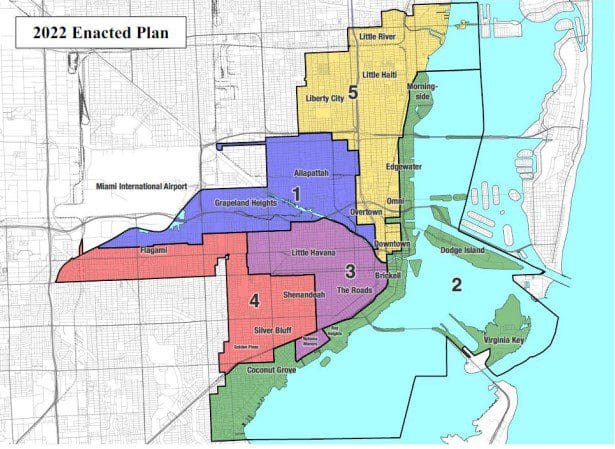A federal judge on Tuesday threw out the City of Miami Commission district map, finding that lines drawn last year amounted to racial gerrymandering. He ordered the maps be redrawn, a significant decision with three city commission seats on the ballot in November.
U.S. District Court Judge Michael Moore granted the ACLU of Florida’s request for an injunction in a lawsuit filed on behalf of community groups, including the Miami-Dade Branch of the NAACP.
Moore adopted a recommendation from a U.S. magistrate to redraw the five district lines in a way that does not use race as a predominant factor.
The ACLU said in its lawsuit the city of Miami violated the U.S. Constitution in approving a map last year that maintained one black district, one white district, and three Hispanic districts.
“Miami’s is not merely a run-of-the-mill racial gerrymander in which the majority seeks to diminish minority voters’ influence and power. Rather, it is the product of a calculated scheme in which communities and neighborhoods were split along racial lines for the predominant purpose of maintaining racially segregated districts,” the ACLU stated in its original complaint.
There are three seats currently occupied by Hispanic incumbents: District 1 represented by Alex Diaz de la Portilla; District 2 represented by Sabino Covo; District 3 represented by Manolo Reyes.
Covo, whose district includes Coconut Grove, Brickell and Virginia Key, just won a special election in February after the incumbent, Ken Russell, resigned to run for Congress.
“We must keep communities of interest intact and neighborhoods like Coconut Grove, Downtown and Brickell together to avoid unnecessary boundary divisions,” Covo said in a statement on Twitter.
The judge wrote that the city commissioners’ own words doomed any argument the map was not racially gerrymandered.
“Our goal here is to have an African American district, for the lack of a better term, a white district, which is the coastal district, and three Hispanic districts,” Moore quoted Diaz de la Portilla.
Support local news. Please give today
In making his ruling, Moore described the “repeated, explicit statements from the majority of the commissioners” that the enacted map would preserve racial breakdowns of previous district maps.
The city argued that even though commissioners spoke about race in redrawing the districts, it did not increase minority representation, black or Hispanic, in any one one district.
“It throws out the entire map for racial gerrymandering because the conversation was racial, even though there was in effect no racial gerrymandering,” the city argued.
Moore adopted the finding of U.S. Magistrate Lauren F. Louis who wrote the current plan divides traditional neighborhoods, such as Coconut Groove and Brickell.
Moore ordered the parties to be prepared at an upcoming status conference on how to implement “a constitutionally conforming remedial map.”
JOHN PACENTI is the executive editor of the Key Biscayne Independent. John has worked for The Associated Press, the Palm Beach Post, Daily Business Review, and WPTV-TV.



